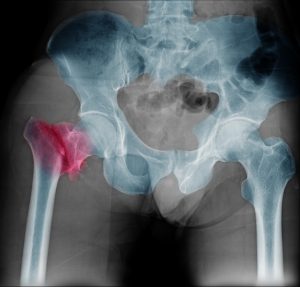Osteoporosis
Living tissues make up the human body and over time, the tissue starts to break down. The complexity of the human body allows the tissues to break down but also regenerate itself with new tissue. Osteoporosis occurs when the bone tissue breaks down but cannot regenerate in adequate time, resulting in brittle weak bones. Studies suggest that over 200 million individuals in the world suffer from osteoporosis. The International Osteoporosis Foundation conducted a study that shows an estimated one in three women over the age of 50 and one in five men may experience a fracture due to osteoporosis. Having weak and brittle bones can lead to further injuries. Many fractures in the hip, wrist, and spine occur due to osteoporosis.
Symptoms of Osteoporosis
Symptoms of osteoporosis may not appear until further bone injury occurs. Patients should get yearly physicals so a physician can monitor their health. All individuals have different pain tolerances so symptoms of osteoporosis may vary among people. The most common symptoms of osteoporosis include:
- Back pain
- Loss of height over time
- Bone fractures that would normally not occur
- A hunched posture
Causes of Osteoporosis
A form of live tissue, bones constantly renew themselves, breaking down old bone to make room for new healthy bone tissue. When growing, new bone gets generated quicker than old bone gets broken down, resulting in an increase of bone mass. With age, the opposite occurs. Bone breaks down quicker than new bone can regenerate. Genetics may play into who develops osteoporosis and at what age, in addition to a number of potential risk factors.
Risk factors for Osteoporosis
Research has shown that several factors play into the development of osteoporosis. Individuals are naturally predisposed to certain risk factors while individuals may avoid others.
Risk factors out of a patients control include:
- Sex
- Age
- Race
- Family History
Hormone levels also play into the development of osteoporosis. Too much or too little of specific hormones may lead to the development of osteoporosis. The three main categories of hormones associated with osteoporosis are:
- Sex
- Age
- Race
- Family History
Hormone levels also play into the development of osteoporosis. Too much or too little of specific hormones may lead to the development of osteoporosis. The three main categories of hormones associated with osteoporosis are:
- Thyroid hormone
- Overactive parathyroid & Adrenal Glands
- Sex Hormones
The risk of developing osteoporosis increases with certain medical conditions. These medical conditions include:
- Cancer
- Lupus
- Celiac Disease
- Inflammatory Bowel Disease
- Rheumatoid Arthritis
Lifestyle choices and diet also play into developing osteoporosis. While poor decisions may not effect the body in present time, individuals should always think of the effect actions may have on the future. Lifestyle choices and diet that leads to the development of osteoporosis include:
- Living a sedentary lifestyle
- Using tobacco products
- Excessive alcohol consumption
- Eating disorders
- Low calcium intake
- Gastrointestinal Surgery
To view a list of all insurances that AOA Orthopedic Specialists accept, click HERE. To schedule an appointment online, click HERE.


